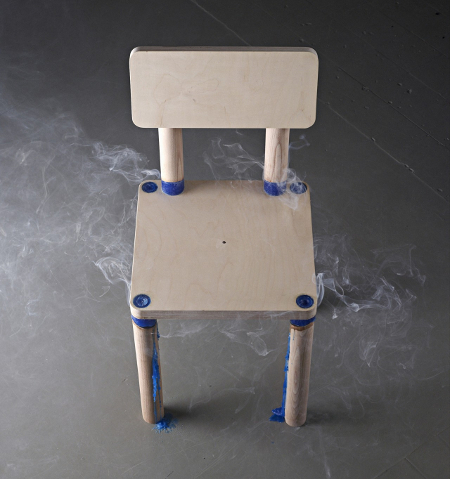How and why: a selection of strange Arduino-projects

If engineers have free time, they either get bored or take a soldering iron in their hands. Or take a soldering iron in the hands of boredom and collect devices like those presented below. For what else, besides boredom, skillful hands and inquisitive brain, can we explain the appearance of the lily, which publishes the note “fa”, or the chair that breaks down after sitting down on the eighth?
Meet the top strange inventions collected on the Arduino.
Food for thought: a third of the projects belong to design college students.
')
Singing plant
It would seem: why should a plant sing? Since the answer to this question is difficult, the project fell into this selection. The author decided to add beauty and fragrance to the theremin - otherwise the principles of work remained almost the same. The model is based on sensory perception , but with the registration of the signal amplitude change. So, a user named madshobye has attached a touch detector to measure capacitance and then convert to a signal.
For all this, he needed an Arduino board, a Gameduino shield and a homemade shield for sensory perception. To be honest, the author flattered himself, calling the project a "singing plant." Judging by the video, the plant is at best just sounding.
Nod Bang system
Another device about the sounds, and literally it does not translate. The idea is that we quite often nod to the beat of the music. Andrew Lee decided that the nod could be music itself, or rather be beat.
The accelerometer built into the headphones responds to nodding of the head, the buttons are responsible for various bits, the Arduino cleans and normalizes the sound, and then broadcasts to the computer via the MIDI USB interface. By default, when you nod, sounds are made as in a metronome, and the buttons are lit in white. But if you click on them, you get to create a full bit. The buttons themselves will, of course, blink beautifully.
"Hugging"
If you believe the scientists, then for a feeling of complete happiness you need to hug at least 8 times a day. But when you rent an apartment with someone else's aunt or you live alone, a hugging avitaminosis develops.
In order not to disturb colleagues and not to throw at random passers-by, the user under the nickname [kaytdek] created Hugbot - “hugging”. The robot will meet anyone with open arms and, if necessary, will give much more hugs than the “daily norm” says.
To build the author used the Arduino Uno.
Arduino foil
Shy foil with an unusual name @> <# !!! - a truly strange project from the German students of the International School of Design Cologne Vitus Schuhwerk and Till Maria Jürgens (like Erich Maria Remarque is also a boy). Nevertheless, this thing caused a great interest in the network, because it is - as alive. Thanks to the invisible fishing line, capacitive sensor, four servo drives and, of course, the Arduino board, the foil “reacts” to the approaching hand and twists in every way.
Self-destructing chair
To put it mildly, one more strange invention belongs to students from the Swiss school of design and arts ECAL in Lausanne. DRM Chair - this is the name of the project - will serve as a seat for all eight users. Only not at once, but consistently: when the eighth person releases the chair, the tired seat will start to self-destruct.
The built-in sensor detects and remembers sitting in the chair. After the user has risen, the chair makes the sounds notifying on quantity of the remained possible squats. When the limit is reached, the trigger will trigger a self-destruct mode: the connecting parts will begin to melt and the chair will collapse.
Auto cordless
Although the future from the second part of the film “Back to the Future” has already arrived , the sneaker, like Marty McFly, Jr., did not appear in the general production. But the user under the blakebevin nickname still managed to design self-weaving sneakers. With the help of an Arduino microcontroller, a pressure sensor and a servo, the shoes are laced up without the owner. But still have to shoe yourself.

Baby name generator
Not able to come to a consensus in choosing a name for the future of the children? When there are more than two options, and the coin is not thrown, the Arduino Baby Name Chooser comes to the rescue - a project from GeekBoy.it. Simply enter all the name options in the source code, and then click on the button of this device. With the help of the board and the great random house, it will give you a name. If in your soul you still hoped for another option, then you can press the button again, and then again, and again, and again - until the inscription on the monochrome display does not suit all the discussion members.
"Maslobot"
This robot on the Arduino is a prototype of a robot from the TV series "Rick and Morty." In the 9th episode of the 1st season, an insanely brilliant scientist assembled a robot for one purpose: to bring oil. The students from Bruface constructed almost the same, only they have it a little more, they are controlled by an IR remote control instead of a voice and do not ask questions about the futility of life.
The device consists of an Arduino Uno, two large and two small servomotors and IR sensors. Butterhead is smart enough to not fall off the table, distinguish oil from other items and store it for a long time before transferring it to the right person.
Watch "Game of Shadows"
The Shadowplay Clock was designed by designers from Breaded Escalope. The trick of the clock is that they show the time with the play of light and shadow from the user's finger. By default, this is an LED luminaire, but thanks to the programmed Arduino board, the LED lamps shine "according to the mind." In other words, if you touch the center of the invisible dial, the shadow from the finger will show time.
Yes, beautiful. Yes, original. But obviously strange. The overwhelming majority of inventions on the Arduino are for the lazy and automate the process (the same “Maslobot”). But in this case, in order for the invention to fulfill its direct function, it must be approached!
Looking at these projects, I want to ask: the author, why? But literally after a couple of seconds, the answer is on its own - just for fun. And in general - and why, actually, no?
Source: https://habr.com/ru/post/374185/
All Articles